There are other things, which are in I-Ching, and nobody had found a communicative link between Chinese history culture and modern Western publication.
The Terracotta-army was found accidently as late as 1974.
Geomancy with its special 16 figures reached nearly every spot on earth, and you want to say, that it never didn't appear in China, a region with very much inhabitants? That's rather unlikely.
Well, the I-Ching was very mighty in China, and perhaps this caused so much respect, that the very similar geomancy was just integrated as a part of I-Ching. Possibly this explains something.
... .-) ... it's not important to me, if you believe me or not. It's just too obvious.
You wanted to tell me something about Geomancy and a connection to the 22 animals in Bollstatter's version.
Re: The Pope with the donkey / "Oldest Tarot"
82Me ( viewtopic.php?f=11&t=663&start=70 ):
Sure. Oookaaey ... have fun!
Adrian
You ( viewtopic.php?f=11&t=663&start=80 ):... you make a conversation about a difficult subject very odd and complicated ...
Me ( "minding" your business):... it's not important to me, if you believe me or not. It's just too obvious.
Me (speaking to you):
Sure. Oookaaey ... have fun!
Adrian
Re: The Pope with the donkey / "Oldest Tarot"
83... .-) nice hare
It's 30 years ago, that I found that, so I really don't bother, if somebody believes my conclusion about it or not. Chinese history is long, full of details and full of difficulties in the communicative situation (very distant language). It's much easier to research Italian details.
It's not personal.
***************
Resources:
Hebräische Losbuchschriften: Zur Typologie einer jüdischen Divinationsmethode.
by Evelyn Burkhardt (Berlin), p. 95
in Jewish Studies Between the Disciplines
by Peter Schèafer, Klaus Herrmann, Margarete Schlèuter, Giuseppe Veltri
BRILL, 01.01.2003 - 502 Seiten
https://books.google.de/books?id=xDdOLo ... er&f=false
CPG552
----------
http://bilder.manuscripta-mediaevalia.d ... Cpg552.pdf
http://digi.ub.uni-heidelberg.de/diglit/cpg552
It's 30 years ago, that I found that, so I really don't bother, if somebody believes my conclusion about it or not. Chinese history is long, full of details and full of difficulties in the communicative situation (very distant language). It's much easier to research Italian details.
It's not personal.
***************
Resources:
Hebräische Losbuchschriften: Zur Typologie einer jüdischen Divinationsmethode.
by Evelyn Burkhardt (Berlin), p. 95
in Jewish Studies Between the Disciplines
by Peter Schèafer, Klaus Herrmann, Margarete Schlèuter, Giuseppe Veltri
BRILL, 01.01.2003 - 502 Seiten
https://books.google.de/books?id=xDdOLo ... er&f=false
CPG552
----------
http://bilder.manuscripta-mediaevalia.d ... Cpg552.pdf
http://digi.ub.uni-heidelberg.de/diglit/cpg552
Huck
http://trionfi.com
http://trionfi.com
Re: The Pope with the donkey / "Oldest Tarot"
84Of course. I knew that you would say that.... nice hare
And of course it's nothing personal. It's just business. Your's.
You should know from MY posts that I'm all about "thinking out of the box" but I do not feed "Schroedinger's cat" when nobody's looking.
I prefer to think that the cat is dead to save my time for things I really need to do - so the cat can still be fine when you decide to open a new can of worms.
I can not discuss a matter of such importance under those circumstances you provide.
Adrian
Re: The Pope with the donkey / "Oldest Tarot"
85
Well, I guess, it's not my fault, that your clever reasoning about the complicated geomancy system doesn't allow your mind to count till 4.
It's a common failure in research, that the simple and trivial explanation is overlooked.
Perhaps my modification of the picture from ...
http://www.thetolteciching.com/blog/con ... hexagrams/
... helps.
4 lines are used to construct a hexagram with 6 lines.
I guess, that nobody really knows, for what this is good for. Essentially there are the 4 lines, which are used to generate a hexagram with 6 lines. Naturally only 16 hexagrams can be generated by this method.
Somehow Richard Wilhelm at p.329/330 explains, that this system is of some value, but the explanations stay very thin and the whole text book (the first part and the third part) stay free of it. Somehow Richard Wilhelm uses it to explain, that 1st and the last line are outside of the major action and the 3rd and 4th line have most action. But that's all. But this one could also explain with general line definitions, one doesn't need the not necessary system.
******************
About the terminus geomancy in Chinese contexts:
https://en.wikipedia.org/wiki/Geomancy
In the 19th century, Christian missionaries in China translated feng shui as "geomancy" due to their observations of local shamans and priests manipulating the flow and direction of energy based on aesthetics, location, and position of objects and buildings. Although it stems from a distinct tradition, the term "geomancy" now commonly includes feng shui. Similarly, the introduction of a similar Indian system of aesthetics and positioning to harmonize the local energies, vastu shastra, has come under the name "geomancy". Due to the definition having changed over time (along with the recognized definition of the suffix -mancy), "geomancy" can cover any spiritual, metaphysical, or pseudoscientific practice that is related to the Earth. In recent times the term has been applied to a wide range of other occult and fringe activities, including Earth mysteries and the introduction of ley lines and Bau-Biologie.
Huck
http://trionfi.com
http://trionfi.com
Re: The Pope with the donkey / "Oldest Tarot" ; theme lotboo
86http://www.jewishencyclopedia.com/artic ... l-loosbuchAHITHOPHEL LOOSBUCH:
By: H. G. Enelow
A book of fate used in popular divination and named after Ahithophel. In Jewish legends of the Middle Ages Ahithophel plays a rôle somewhat similar to that of Mephistopheles (see Steinschneider, "Pseudepigraphische Literatur," p. 80, note 2). Cassel would even translate "Ahithophel" as "the Brother of the Evil One"; regarding tofel as an ancient formation of diabolus, in support of which he cites the Germanic tiuval and tievel-teufel (compare "Mischle Sindbad," p. 330, Berlin, 1888). R. Moses Isserles, again, relates having read in a "very old book," in which were contained the philosophies and the portraits of various thinkers, that Socrates had received his wisdom from Asaf the Korahite and Ahithophel ("Torat ha-'Olah," i. xi.). In accordance with the popular view of Ahithophel's character, as being at once diabolic and omniscient, in the Middle Ages the authorship of a cabalistic work, "Sefer Goralot" (Book of Lots), was attributed to him. According to its preface, it discloses the "great secret of securing an answer without the drawing of lots or computation, by indifferently putting one's hand on a tablet containing the numbers one to ninety, or eighty-nine." The book furthermore is said to have lain hidden in Alexandria, and afterward to have been used in Tiberias and elsewhere, "the usual legend concerning pseudepigraphic writings," as Steinschneider puts it.
https://en.wikipedia.org/wiki/Ahitophel
... describes Ahitophel as very important and close to King David.
... was a counselor of King David and a man greatly renowned for his sagacity. During Absalom's revolt he deserted David (Psalm 41:9; 55:12–14) and supported Absalom (2 Samuel 15:12).
...
... Ahithophel was granted access by Almighty God into the Divine powers of the Holy Name (YHWH). And being thus familiar with Divine wisdom and knowledge as imparted through the Holy Spirit, he was consulted as an oracle like the Urim we-Tummim (2 Samuel 16:23, Yer. Sanh. x. 29a, Suk. 53a et seq.). But he withheld his mystic knowledge from King David in the hour of peril, and was therefore doomed to die from strangulation (Tanna debe Eliyahu R. xxxi., Mid. Teh. iii. 7; Ex. R. iv., Mak. 11a). "Ahitophel of the house of Israel and Balaam of the heathen nations were the two great sages of the world who, failing to show gratitude to God for their wisdom, perished in dishonor. To them the prophetic word finds application: 'Let not the wise man glory in his wisdom,' Jer. ix. 23" (Num. R. xxii.).
...
Ahithophel was thirty-three years old when he died.
...
Christian interpreters often see Judas Iscariot as an antitype to Ahithophel. Ahithophel's betrayal of David, and subsequent suicide are seen as anticipating Judas' betrayal of Jesus, and the gospel's account of Judas hanging himself (Matthew 27:5). Psalm 41:9, which seems to refer to Ahithophel, is quoted in John 13:18 as being fulfilled in Judas.[2]

https://books.google.de/books?id=PMk5AA ... th&f=false
A "Sepher Goraloth" version in Gießen 1714 is attributed to Saadia Gaon, a modern version to Chaim Vital ...
http://www.goodreads.com/book/show/1781 ... of_Oracles
*************
Added: Ahithophel became grand-grandfather of Salomon
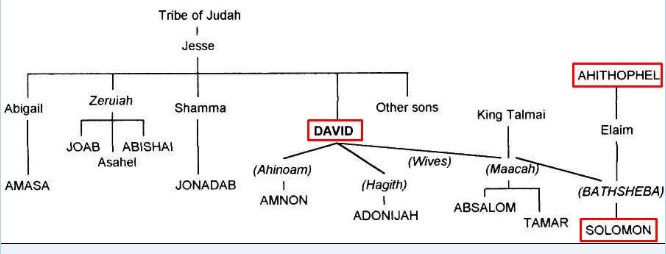
Huck
http://trionfi.com
http://trionfi.com
Re: The Pope with the donkey / "Oldest Tarot" ; theme lotboo
87In the interest to get some overview about the complex lot book publications of the past I arranged a place at ...
Lot book collection ; theme lotbook
viewtopic.php?f=11&t=1171
... to reach some sorting. It's still in development.
For the thread "The Pope with the donkey / "Oldest Tarot"" it was arranged this ...
Lot book collection ; theme lotbook
viewtopic.php?f=11&t=1171
... to reach some sorting. It's still in development.
For the thread "The Pope with the donkey / "Oldest Tarot"" it was arranged this ...
I'll add this to the start of the thread.The Pope with the donkey / "Oldest Tarot" ; theme lotbook (started 21 Feb 2011)
Start: viewtopic.php?f=11&t=663&p=9888#p9888
1. Fränkisches Losbuch (1425-50)
online: http://www.bildindex.de/document/obj00022941#|home
2. Lot book version of c. 1520, in Landshut printed by Johann Weißenburger
online: http://daten.digitale-sammlungen.de/~db ... 06&seite=1
3. Bollstatter lot book collection (Cgm 312) ... between them a text with big similarities to 1. and 2.
online: https://bildsuche.digitale-sammlungen.d ... &nav=&l=en
Description of Cgm 312:
... http://bilder.manuscripta-mediaevalia.d ... 95_JPG.htm
... http://bilder.manuscripta-mediaevalia.d ... 96_JPG.htm
This is the MAJOR TOPIC of the thread: The online edition wasn't known at the beginning of the thread. It's discussion starts at ... viewtopic.php?f=11&t=663&p=18365&hilit= ... ter#p18365
Before the text was studied by Nr. 2 (version of 1520)
--
Other relatives to the 3 lot books above:
4. Trier version (Hs. 1121/1325)
Description: https://books.google.de/books?id=-itYVP ... &q&f=false
appeared in the discussion at ... viewtopic.php?f=11&t=663&p=9888&hilit=trier#p9888
5. Splendor Solis ... a very distant relation
appeared in the discussion at ... viewtopic.php?f=11&t=663&p=9908&hilit=splendor#p9908
6. Heidelberger version with 32 animals instead of 22 (Cod. Pal. germ. 7)
online: http://digi.ub.uni-heidelberg.de/diglit ... fc1c30dacc
appeared in the discussion at ... viewtopic.php?f=11&t=663&p=15544&hilit= ... erg#p15544
--
Other lot books mentioned in this thread:
7. Another lot book system (system 16-16-16-16) described in Cgm 312 at 120r-143v
discussed at viewtopic.php?f=11&t=663&start=50#p18395
description: http://bilder.manuscripta-mediaevalia.d ... 00_JPG.htm
online (start): https://bildsuche.digitale-sammlungen.d ... &nav=&l=es
8. Bolte takes No. 7 as similar to a lot book "Geomantia" of 1532
online: https://bildsuche.digitale-sammlungen.d ... riff=&l=en
dicussed at the end of post viewtopic.php?f=11&t=663&start=50#p18395
9. Babylonian lot book 177/78 BC
discussed at viewtopic.php?f=11&t=663&start=20#p9935
reported at: http://www.persee.fr/doc/syria_0039-794 ... _33_1_5177
"Ein Losbuch in Keilschrift aus der Seleukidenzeit" by Ernst Weidner, Syria Année 1956 Volume 33 Numéro 1 pp. 175-183
10. "Sepher Goraloth" by Ahitophel and others
viewtopic.php?f=11&t=663&start=80#p19147
Huck
http://trionfi.com
http://trionfi.com
Re: The Pope with the donkey / "Oldest Tarot" ; theme lotboo
88This scene ...
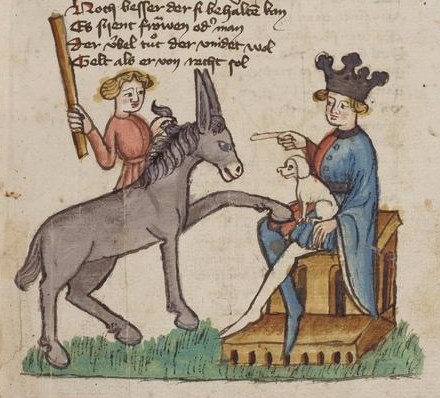
... remembered me on the Pope with donkey scene:
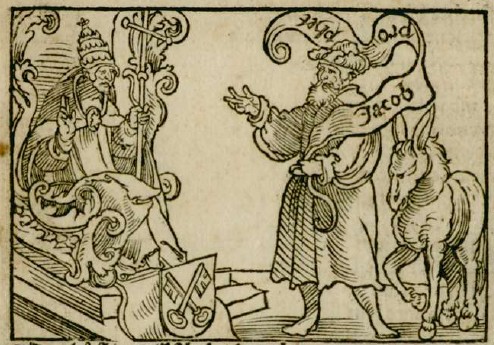
However, the scene belongs not to a lot book, but to a work with 100 fables ...
http://digi.ub.uni-heidelberg.de/diglit ... rrent_page
--- by Ulrich Boner (c. 1415) ...
https://en.wikipedia.org/wiki/Ulrich_Boner
https://de.wikipedia.org/wiki/Ulrich_Boner
... for Ludwig III von der Pfalz:
https://de.wikipedia.org/wiki/Ludwig_III._(Pfalz)
... well, that's the same man, for which also the lot book with 32 animals was made (as reported in his thread) ...
viewtopic.php?f=11&t=663&start=40#p15544
That's the interesting point: Ludwig III seems to have had a general interest in animals.
A version of this book became 1461 the first book in German language printed by movable letters. So this is a big ancestor of all German books.
... .-) ... possibly it's not really an accident, that the major contribution to the Tarot development became the Animal Tarock.

Hares and Dogs
http://diglib.hab.de/wdb.php?dir=inkuna ... yp=2&size=
The expensive German decks of 15th century were mostly hunting decks.

... remembered me on the Pope with donkey scene:

However, the scene belongs not to a lot book, but to a work with 100 fables ...
http://digi.ub.uni-heidelberg.de/diglit ... rrent_page
--- by Ulrich Boner (c. 1415) ...
https://en.wikipedia.org/wiki/Ulrich_Boner
https://de.wikipedia.org/wiki/Ulrich_Boner
... for Ludwig III von der Pfalz:
https://de.wikipedia.org/wiki/Ludwig_III._(Pfalz)
... well, that's the same man, for which also the lot book with 32 animals was made (as reported in his thread) ...
viewtopic.php?f=11&t=663&start=40#p15544
That's the interesting point: Ludwig III seems to have had a general interest in animals.
A version of this book became 1461 the first book in German language printed by movable letters. So this is a big ancestor of all German books.
... .-) ... possibly it's not really an accident, that the major contribution to the Tarot development became the Animal Tarock.

Hares and Dogs
http://diglib.hab.de/wdb.php?dir=inkuna ... yp=2&size=
The expensive German decks of 15th century were mostly hunting decks.
Huck
http://trionfi.com
http://trionfi.com
Re: The Pope with the donkey / "Oldest Tarot" ; theme lotboo
89In the German wiki-article to Ludwig III the information is given, that a "Sittichgesellschaft" (parrot or parakeet society) was founded by the foes of Ludwig VII the Bearded against him. Elector Palatine Louis III participated.
https://de.wikipedia.org/wiki/Sittichgesellschaft
As already reported Ludwig III von der Pfalz had been the owner of 32-animals lot book. The earliest producer of the lot book system with 22 animals isn't known, but likely from the same region.
Parrot or Parakeet and the raven are figures in these systems, the raven has in any case a great importance in the 22-version.
Ludwig VII the Bearded adapted the raven of Oswald of Northumbria at least in 1413. The Parrot society was founded in 1414. The conflict endured a long time, at its height it was open war.

Full picture: https://de.wikipedia.org/wiki/Oswald_(N ... Oswald.jpg
Saint Oswald with raven
https://de.wikipedia.org/wiki/Sittichgesellschaft
The Parakeet Society was a union of the enemies of Louis VII the Bearded, duke of Bavaria-Ingolstadt. It was founded on April 17, 1414 by his cousin, duke Henry XVI of Bavaria-Landshut. The other members of the society were Ernest of Bavaria-Munich, his brother William III and John, Count Palatine of Neumarkt.
On February 16, 1415, Frederick of Nuremberg and Elector Palatine Louis III became members of the society. Its members met on July 8, 1415 at the Council of Constance and turned the society into a union for mutual defense against Louis VII, the League of Constance, to persist until Louis’ death.
All the members of the Parakeet Society were princes. The symbol of the society, the parakeet, was intended to make fun of Louis’ coat of arms, which showed the raven of Oswald of Northumbria.
As already reported Ludwig III von der Pfalz had been the owner of 32-animals lot book. The earliest producer of the lot book system with 22 animals isn't known, but likely from the same region.
Parrot or Parakeet and the raven are figures in these systems, the raven has in any case a great importance in the 22-version.
Ludwig VII the Bearded adapted the raven of Oswald of Northumbria at least in 1413. The Parrot society was founded in 1414. The conflict endured a long time, at its height it was open war.

Full picture: https://de.wikipedia.org/wiki/Oswald_(N ... Oswald.jpg
Saint Oswald with raven
Huck
http://trionfi.com
http://trionfi.com
Re: The Pope with the donkey / "Oldest Tarot" ; theme lotboo
90http://www.handschriftencensus.de/25362
One gets it, if one searches for keyword "SpisyFF_131-1968-1_3.pdf"

The text from Olmütz wasn't known before this article.
The author sees a relation to the lot book with the 32 animals ("Cod. pal. germ. 7").
Also he notes the Bernardus Sylvestris texts in the context (one version was presented in this thread). The author notes ... "London addit. ms. 25435, 16 Bl. 14.-15. Jahrh; Berlin, ms. germ. fol. 563; Cod. pal germ. 3, 16 bl."
... with "die allesamt als deutsche Übersetzungen und Bearbeitungen des dem zu Beginn des 12. Jhts. zu Utrecht lebenden Bernardus Sylvester zugeschriebenen lat. Punktierbuchs anzusehen sind"). All 3 are seen as German translations based on Bernardus Sylvester.
Cod. pal. germ. 3 is online as "Mondwahrsagebuch" c. 1400
http://digi.ub.uni-heidelberg.de/diglit ... rrent_page
ms. germ. fol. 563 is online as "Mondbuch nach den 28 Mondstationen", second half of 15th century
http://digital.staatsbibliothek-berlin. ... 001&DMDID=
Bolte knew about "Cod. pal. germ. 7" (32 animals), but kept his contribution to it very short, so that Zatocil assumes, that Bolte hadn't seen it.
Zatocil expresses his opinion, that the lot book group of Bernardus Sylvester belongs to another line of lot book development than the Heidelberg and Olmütz versions. He gives a vague relation to the Socrates Basileus group.
Zatocil starts to describe the Olmütz version. At the begin are entries about earlier owners of the book.

The text has a handwritten addition from the year 1861 together with 4 old papers with astrological content :
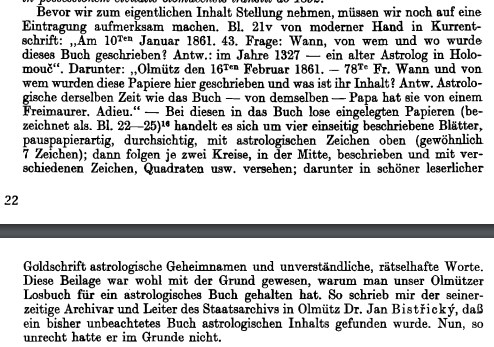
Somebody noted on this papers, that the book was written in 1327 by an old astrologer in Holomouc (= Olmütz). The 4 papers and the book are claimed to have been made around the same time. It's written, that "Papa" (his/her father) has gotten the book from a freemason.
My own idea: Perhaps the papers included an horoscope, which allowed to conclude on the date 1327.
Then follows the description (page 23 - 26 of the pdf) ... I quote the last page with the row of 32 animals:
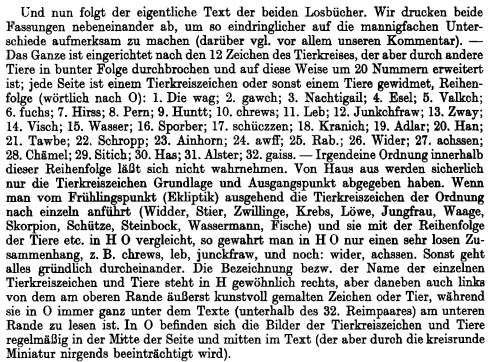
The row in the Heidelberg version is ...
compare viewtopic.php?f=11&t=663&start=40#p15544
*************
Zapocil starts at page 141 a report to DAS LATEINISCHE WAHRSAGEBUCH WENZELS IV .
I guess, I'll later report to this.
The article of Leopold Zatocil is online (German language) as a pdf-fileAufbewahrungsort: Olmütz / Olomouc, Heimatkundliches Museum, K-14905 [früher CO 637]
Codex:
Inhalt Bl. 2r-21r = Traumbuch (Losbuch mit 32 Fragen) / Wahrsagebuch
Literatur
Leopold Zatočil, Die Heidelberger (H) und die Olmützer (O) Losbuchhandschrift, in: ders., Germanistische Studien und Texte I. Beiträge zur deutschen und niederländischen Philologie des Spätmittelalters (Opera Universitatis Purkynianae Brunensis. Facultas Philosophica / Spisy University J. E. Purkynĕ v Brnĕ. Filosofická Fakulta 131), Brünn 1968, S. 11-164, bes. S. 22-26 und 32-36.
Klaus Speckenbach, Traumbücher, in: 2VL 9 (1995), Sp. 1014-1028 + 2VL 11 (2004), Sp. 1558, hier Bd. 9, Sp. 1025.
One gets it, if one searches for keyword "SpisyFF_131-1968-1_3.pdf"

The text from Olmütz wasn't known before this article.
The author sees a relation to the lot book with the 32 animals ("Cod. pal. germ. 7").
Also he notes the Bernardus Sylvestris texts in the context (one version was presented in this thread). The author notes ... "London addit. ms. 25435, 16 Bl. 14.-15. Jahrh; Berlin, ms. germ. fol. 563; Cod. pal germ. 3, 16 bl."
... with "die allesamt als deutsche Übersetzungen und Bearbeitungen des dem zu Beginn des 12. Jhts. zu Utrecht lebenden Bernardus Sylvester zugeschriebenen lat. Punktierbuchs anzusehen sind"). All 3 are seen as German translations based on Bernardus Sylvester.
Cod. pal. germ. 3 is online as "Mondwahrsagebuch" c. 1400
http://digi.ub.uni-heidelberg.de/diglit ... rrent_page
ms. germ. fol. 563 is online as "Mondbuch nach den 28 Mondstationen", second half of 15th century
http://digital.staatsbibliothek-berlin. ... 001&DMDID=
Bolte knew about "Cod. pal. germ. 7" (32 animals), but kept his contribution to it very short, so that Zatocil assumes, that Bolte hadn't seen it.
Zatocil expresses his opinion, that the lot book group of Bernardus Sylvester belongs to another line of lot book development than the Heidelberg and Olmütz versions. He gives a vague relation to the Socrates Basileus group.
Zatocil starts to describe the Olmütz version. At the begin are entries about earlier owners of the book.

The text has a handwritten addition from the year 1861 together with 4 old papers with astrological content :

Somebody noted on this papers, that the book was written in 1327 by an old astrologer in Holomouc (= Olmütz). The 4 papers and the book are claimed to have been made around the same time. It's written, that "Papa" (his/her father) has gotten the book from a freemason.
My own idea: Perhaps the papers included an horoscope, which allowed to conclude on the date 1327.
Then follows the description (page 23 - 26 of the pdf) ... I quote the last page with the row of 32 animals:

The row in the Heidelberg version is ...
compare viewtopic.php?f=11&t=663&start=40#p15544
I compared them. If I'm not in error, there are only 3 differences between the animals (beside various differences in the writing forms) at the position 3, 4 and 5 (only the positions are exchanged). In other words. It's more or less identical, at least in this part.01 Wag (zodiac Waage/Libra, FL 1)
02 Gauch oder Guguck (cuckoo, new)
03 Esel (donkey, FL 22)
04 Falck (falcon, new)
05 Nachtigal (nightingale, FL 16)
06 Fuchs (fox, new)
07 Hierß (stag, FL 19)
08 Per (bear, new)
09 Hunt (dog, FL 20)
10 Krebs (zodiac Krebs/Cancer, FL 4)
11 Leb (zodiac Löwe/Leo, FL 5)
12 Junckfraw (zodiac Jungfrau/Virgo, FL 7)
13 Zwihling (zodiac Zwilling/Gemini, FL 10)
14 Visch (zodiac Fische/Pisces, FL 8)
15 Weßrer (zodiac Wassermann/Aquarius, FL 9)
16 Sperwer (sparrowhawk, new)
17 Schutz (zodiac Schütze/Sagitarius, FL 11)
18 Krannich (crane, FL 14)
19 Adler (eagle, FL 15)
20 Hann (cock, new)
21 Taube (pigeon, new)
22 Scorp (zodiac Scorpio, FL 12)
23 Einhorn (unicorn, zodiac Steinbock/Capricorn, FL 13)
24 Awle (Owl, new)
25 Rab (Raven, 13th zodiac sign, FL 6)
26 Wieder (zodiac Aries, FL 2)
27 Ochß (Einhorn, zodiac Taurus, FL 3)
28 Kamel (camel, FL 17)
29 Sitich (parrot, FL 18)
30 Haß (Hare FL 21)
31 Aglaster (bird, Elster = magpie ?, new)
32 Gaiß (goat, new)
*************
Zapocil starts at page 141 a report to DAS LATEINISCHE WAHRSAGEBUCH WENZELS IV .
I guess, I'll later report to this.
Huck
http://trionfi.com
http://trionfi.com

